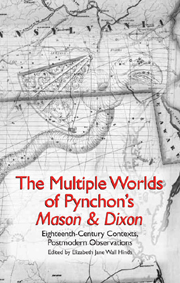 The Multiple Worlds of Pynchon's 'Mason and Dixon'
The Multiple Worlds of Pynchon's 'Mason and Dixon' from The Rounds of History
Published online by Cambridge University Press: 12 September 2012
So if I draw a boundary line that is not yet to say what I am drawing it for.
— Ludwig Wittgenstein, Philosophical InvestigationsAT THE CONCLUSION OF Mason & Dixon's thirty-second chapter, Jeremiah Dixon receives a letter from his long-time mentor, William Emerson, who has entrusted Dixon with a watch of perpetual motion that never requires winding. Dixon has written to Emerson to report that the watch was swallowed by R.C., a member of the surveying party, and Emerson's reply bears the challenging post-script, “Time is the Space that may not be seen. —” (326). This essay reads Mason & Dixon as a literary attempt, not to render time visible, but to produce meaning from time itself. As such, Thomas Pynchon incorporates temporality into the narrative's production, not only writing about the historical interface between the eighteenth and twentieth centuries, but also performing the historicity of that interface. To make meaning from time's perpetual motion, Pynchon employs a temporally parallactic narrative form (different narrators deliver the story from ostensibly different moments in time) that effects, for the reader, a semblance of experiential time. These narrative tricks superimpose linear and cyclical models of time into one textual form, and they allow Pynchon to write about time without sacrificing, by spatializing, time's temporality or history's historicity.
To save this book to your Kindle, first ensure [email protected] is added to your Approved Personal Document E-mail List under your Personal Document Settings on the Manage Your Content and Devices page of your Amazon account. Then enter the ‘name’ part of your Kindle email address below. Find out more about saving to your Kindle.
Note you can select to save to either the @free.kindle.com or @kindle.com variations. ‘@free.kindle.com’ emails are free but can only be saved to your device when it is connected to wi-fi. ‘@kindle.com’ emails can be delivered even when you are not connected to wi-fi, but note that service fees apply.
Find out more about the Kindle Personal Document Service.
To save content items to your account, please confirm that you agree to abide by our usage policies. If this is the first time you use this feature, you will be asked to authorise Cambridge Core to connect with your account. Find out more about saving content to Dropbox.
To save content items to your account, please confirm that you agree to abide by our usage policies. If this is the first time you use this feature, you will be asked to authorise Cambridge Core to connect with your account. Find out more about saving content to Google Drive.